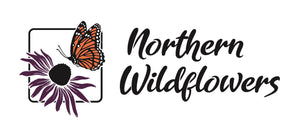
Finally a wildflower mixture that will thrive in Canadian gardens! Our wildflower mixes are formulated with an ideal ratio of wildflower to grass species and the appropriate amount of seed for your application site. Our mixes contain spring, summer and fall blooms in a variety of colours to provide a continuous nectar supply for pollinators.
The 'Dry and Sunny Mix' is suited to full sun areas and sites with dry to medium conditions. The mix is ideal for fall sowing. Spring sowing is possible, however note some species may not come up until the following spring (after they overwinter).
For your convenience, this mix also includes our eco-friendly seed coating. We've coated the small-seeded varieties with a biodegradable mix of natural minerals to make application easier and increase germination rates.
Contains: Common Milkweed (Asclepias syriaca), Black-Eyed Susans (Rudbeckia hirta), Grey-Headed Coneflower (Ratibida pinnata), Wild Bergamot (Monarda fistulosa), Dotted Mint (Monarda punctata), Oxeye Sunflower (Heliopsis helianthoides), Pale Purple Coneflower (Echinacea pallida), Canada Tick Trefoil (Desmodium canadense), Lanceleaf Coreopsis (Coreopsis lanceolata), Butterfly Milkweed (Asclepias tuberosa), Common Evening Primrose (Oenothera biennis), New England Aster (Symphyotrichum novae-angliae), Hoary Vervain (Verbena stricta), Smooth Blue Aster (Symphyotrichum laevis), Leadplant (Amorpha canascens), Anise Hyssop (Agastache foeniculum), Savannah Grass (Sorghastrum nutans), Little Bluestem (Schizachyrium scoparium), Switchgrass (Panicum virigatum) and Sideoats Grama (Bouteloua curtipendula).
General Sowing Instructions
Ideally, direct garden sowing should take place in the late fall after the first frost, mid September to end of October. This allows seeds to overwinter outdoors, which imitates their natural dormancy period and improves germination. Early spring sowing can be done directly outdoors from April to July, if seeds are overwintered/ stratified for 6-8 weeks beforehand. Note, if seeds cannot be stratified, many will not germinate until the following spring and germination rates may be slightly lower.
Site Prep
Remove existing vegetation then lightly work the soil to ensure compaction does not impede germination. Rake a fine seedbed then broadcast the seed evenly across the area. In order to ensure good soil/ seed contact, use a seed roller or walk over seeds for smaller sites. Do not bury the seeds- they should ideally have good contact with the soil but still be exposed to sunlight. For spring planting, keep evenly watered through the first two weeks of germination, or until seedlings are strong and well established. For fall planting, watering is not generally required.
Patience is required when establishing a mix of native grasses and perennials as many flowers will not bloom until the second year of growth. After the first year of growth, a fall mowing to 15cm height is beneficial to help spread seeds and control weed growth the following spring.













































